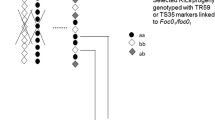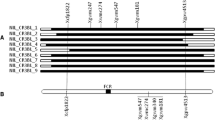Abstract
A composite linkage map was constructed based on two interspecific recombinant inbred line populations derived from crosses between Cicer arietinum (ILC72 and ICCL81001) and Cicer reticulatum (Cr5-10 or Cr5-9). These mapping populations segregate for resistance to ascochyta blight (caused by Ascochyta rabiei), fusarium wilt (caused by Fusarium oxysporum f. sp. ciceris) and rust (caused by Uromyces ciceris-arietini). The presence of single nucleotide polymorphisms in ten resistance gene analogs (RGAs) previously isolated and characterized was exploited. Six out of the ten RGAs were novel sequences. In addition, classes RGA05, RGA06, RGA07, RGA08, RGA09 and RGA10 were considerate putatively functional since they matched with several legume expressed sequences tags (ESTs) obtained under infection conditions. Seven RGA PCR-based markers (5 CAPS and 2 dCAPS) were developed and successfully genotyped in the two progenies. Six of them have been mapped in different linkage groups where major quantitative trait loci conferring resistance to ascochyta blight and fusarium wilt have been reported. Genomic locations of RGAs were compared with those of known Cicer R-genes and previously mapped RGAs. Association was detected between RGA05 and genes controlling resistance to fusarium wilt caused by races 0 and 5.



Similar content being viewed by others
References
Altschul SF, Madden TL, Schaffer AA, Zhang JH, Zhang Z, Miller W, Liman DJ (1997) Gapped BLAST and PSI-BLAST: a new generation of protein database search programs. Nucleic Acids Res 25:3389–3402
Campbell TA (2003) Investigation of variations in NBS motifs in alfalfa (M. sativa), M. edgeworthii and M. ruthenica. Can J Plant Sci 83:371–376
Churchill GA, Doerge RW (1994) Empirical threshold values for quantitative trait mapping. Genetics 138:963–971
Cobos MJ, Fernández MJ, Rubio J, Kharrat M, Moreno MT, Gil J, Millán T (2005) A linkage map in chickpea (Cicer arietinum L) in two populations from Kabuli × Desi crosses: location of a resistance gene for fusarium wilt race 0. Theor Appl Genet 110:1347–1353
Cobos MJ, Rubio J, Strange RN, Moreno MT, Gil J, Millán T (2006) A new QTL for Ascochyta blight resistance in a RIL population derived from a interspecific cross in chickpea. Euphytica 149:105–111
Cobos MJ, Winter P, Kharrat M, Cubero JI, Gil J, Millan T, Rubio J (2008) Genetic analysis of agronomic traits in a wide cross of chickpea. Field Crop Res (in press)
Deng Z, Huang S, Ling P, Chen C, Yu C, Weber CA, Moore GA, Gmiter FGJR (2000) Cloning and characterization of NBS-LRR class resistance-gene candidate sequences in citrus. Theor Appl Genet 101:814–822
Díaz-Franco A, Pérez-García P (1995) Control químico de la roya y la rabia del garbanzo y su influencia en el rendimiento de grano. Revista Mexicana de Fitopatología 13:123–125
FAOSTAT (2008) http://faostat.fao.org. Last update June 2008
Flandez-Galvez H, Ades PK, Ford R, Pang ECK, Taylor PWJ (2003a) QTL analysis for ascochyta blight resistance in an intraspecific population of chickpea (Cicer arietinum L.). Theor Appl Genet 107:1257–1265
Flandez-Galvez H, Ford R, Pang ECK, Taylor PWJ (2003b) An intraspecific linkage map of the chickpea (Cicer arietinum L.) genome based on sequence tagged microsatellite site and resistance gene analog markers. Theor Appl Genet 106:1447–1456
Gupta PK, Roy JK, Prasad M (2001) Single nucleotide polymorphisms: a new paradigm for molecular marker technology and DNA polymorphism detection with emphasis on their use in plants. Curr Sci 80:524–535
Halila I, Cobos MJ, Rubio J, Millán T, Kharrat M, Marrakchi M, J Gil (2008) Tagging and mapping a second resistance gene for Fusarium wilt race 0 in chickpea. Eur J Plant Pathol. doi:10.1007/s10658-008-9395-x
Hall TA (1999) BioEdit: a user-friendly biological sequence alignment editor and analysis program for Windows 95/98/NT. Nucleic Acids Symp Ser 41:95–98
Huettel B, Santra D, Muehlbauer FJ, Kahl G (2002) Resistance gene analogues of chickpea (Cicer arietinum L.): isolation, genetic mapping and association with a Fussarium resistance gene cluster. Theor Appl Genet 105:479–490
Iruela M, Rubio J, Barro F, Cubero JI, Millán T, Gil J (2006) Detection of two quantitative trait loci for resistance to ascochyta blight in an intra-specific cross of chickpea (Cicer arietinum L.): development of SCAR markers associated with resistance. Theor Appl Genet 112:278–287
Iruela M, Castro P, Rubio J, Cubero JI, Jacinto C, Millán T, Gil J (2007) Validation of a QTL for resistance to ascochyta blight linked to resistance to fusarium wilt race 5 in chickpea (Cicer arietinum L.). Eur J Plant Pathol 119:20–37
Komori T, Nitta N (2005) Utilization of the CAPS/dCAPS method to convert rice SNPs into PCR-based markers. Breeding Sci 55:93–98
Konieczny A, Ausubel FM (1993) A procedure for mapping Arabidopsis mutations using co-dominant ecotype-specific PCR-based markers. Plant J 4:403–410
Kuhn Dn, Heath M, Wisser RJ, Meerow A, Brow JS, Lopes U, Schnell RJ (2003) Resistance gene homologues in Theobroma cacao as useful genetic markers. Theor Appl Genet 107:191–202
Kumar J, Haware MP (1983) Wilt-resistant Kabuli strains developed at ICRISAT. Int Chickpea Newsl 8:7–8
Lander ES, Botstein D (1989) Mapping Mendelian factors underlying quantitative traits using RFLP linkage map. Genetics 121:185–199
Leister D, Kurth J, Laurie DA, Yano M, Sasaki T, Devos K, Graner A, Schulze-Lefert P (1998) Rapid reorganization of resistance gene homologues in cereal genomes. Proc Natl Acad Sci USA 95:370–375
Madrid E, Rubiales D, Moral A, Moreno MT, Millán T, Gil J, Rubio J (2008) Mechanism and molecular markers associated with rust resistance in a chickpea interspecific cross (Cicer arietinum × Cicer reticulatum). Eur J Plant Pathol 121:43–53
McIntyre CL, Casu RE, Drenth J, Knight D, Whan VA, Croft BJ, Jordan DR, Manners JM (2005) Resistance gene analogues in sugarcane and sorghum and their association with quantitative trait loci for rust resistance. Genome 48:391–400
Meyers BC, Dickerman AW, Michelmore RW, Sivaramakrishnan S, Sobral BW, Young ND (1999) Plant disease resistance genes encode members of an ancient and diverse protein family within the nucleotide-binding superfamily. Plant J 20:317–332
Michelmore RW, Meyers BC (1998) Clusters of resistance genes in plants evolve by divergent selection and a birth-and-death process. Genome Res 8:1113–1130
Millán T, Clarke HJ, Siddique KHM, Buhariwalla HK, Gaur PM, Kumar J, Gil J, Kahl G, Winter P (2006) Chickpea molecular breeding: new tools and concepts. Euphytica 147:81–103
Neff MM, Joseph JD, Chory J, Pepper AE (1998) dCAPS, a simple technique for the genetic analysis of single nucleotide polymorphisms: experimental applications in Arabidopsis thaliana genetics. Plant J 14:387–392
Noir S, Combes MC, Anthony F, Lashermes P (2001) Origin, diversity and evolution of NBS-type disease-resistance gene homologues in coffee trees (Coffea L.). Mol Genet Genomics 265:654–662
Palomino C, Satovic Z, Cubero JI, Torres AM (2006) Identification and characterization of NBS-LRR class resistance gene analogs in faba bean (Vicia faba L.) and chickpea (Cicer arietinum L.). Genome 49:1227–1237
Pande S, Siddique KHM, Kishore GK, Bayaa B, Gaur PM, Gowda CLL, Bretag TW, Crouch JH (2005) Ascochyta blight of chickpea (Cicer arietinum L.): a review of biology, pathogenicity and disease management. Aust J Agric Res 56:317–332
Quint M, Dussle CM, Mechinger AE, Luebberstedt T (2003) Identification of genetically linked RGAs by BAC screening in maize and implications for gene cloning, mapping and MAS. Theor Appl Genet 106:1171–1177
Radhika P, Gowda SJM, Kadoo NY, Mhase LB, Jamadagni BM, Sainani MN, Chandra S, Gupta VS (2007) Development of an integrated intraspecific map of chickpea (Cicer arietinum L.) using two recombinant inbred line populations. Theor Appl Genet 115:209–216
Radwan O, Bouzidi MF, Vear F, Philippon J, Tourvieille de Labrouche D, Nicolas P, Mouzeyar S (2003) Identification of non TIR-NBS-LRR markers linked to the PI5/PI8 locus for resistance to downy mildew in sunflower. Theor Appl Genet 106:1438–1446
Rossi M, Araujo PG, Paulet F, Garsmeur O, Dias VM, Chen H, Van Sluys MA, D’Hony A (2003) Genomic distribution and characterization of Est-derived resistance gene analogues (RGAs) in sugarcane. Mol Genet Genomics 269:406–419
Rychlik W (1995) Selection of primers for polymerase chain reaction. Mol Biotechnol 3:129–134
Sharma KD, Muehlbauer FJ (2007) Fusarium wilt of chickpea: physiological specialization, genetics of resistance and resistance gene tagging. Euphytica 157:1–14
Tamura K, Dudley J, Nei M, Kumar S (2007) Genetics analysis (MEGA) software version 4.0. Mol Biol Evol 24:1596–1599
Tar’an B, Warkentin TD, Tullu A, Vandenberg A (2007) Genetic mapping of ascochyta blight resistance in chickpea (Cicer arietinum L.) using a simple sequence repeat linkage map. Genome 50:26–34
Tekeoglu M, Rajesh PN, Muehlbauer FJ (2002) Integration of sequenced tagged microsatellite sites to the chickpea genetic map. Theor Appl Genet 105:847–854
Timmerman-vaughan GM, Frew TJ, Weeden NF (2000) Characterization and linkage mapping of R-gene analogous DNA sequences in pea (Pisum sativum L). Theor Appl Genet 101:241–247
Udupa SM, Baum M (2003) Genetic dissection of pathotype-specific resistance to ascochyta blight resistance in chickpea (Cicer arietinum L.) using microsatellite markers. Theor Appl Genet 106:1196–1202
van Ooijen JW (1992) Accuracy of mapping quantitative trait loci in autogamous species. Theor Appl Genet 84:803–811
van Ooijen JW (2004) MapQTL ver.5. Software for the mapping of quantitative trait loci in experimental populations. Kyazma BV, Wageningen
van Ooijen JW (2006) JoinMap ver.4. Software for the calculation of genetic linkage maps in experimental populations. Kyazma BV, Wageningen
Wicker T, Yahiaoui N, Keller B (2007) Illegitimate recombination is a major evolutionary mechanism for initiating size variation in plant resistance genes. Plant J 51:631–641
Winter P, Benko-Iseppon AM, Huettel B, Ratnaparkhe M, Tullu A, Sonnante G, Pfaff T, Tekeoglu M, Santra D, Sant VJ, Rajesh PN, Kahl G, Muehlbauer FJ (2000) A linkage map of the chickpea (Cicer arietinum L.) genome based on recombinant inbred lines from a C. arietinum × C. reticulatum cross: localization of resistance genes for fusarium wilt races 4 and 5. Theor Appl Genet 101:1155–1163
Winter P, Pfaff T, Udupa SM, Huettel B, Sharma PC, Sahi S, Arreguin-Espinoza R, Weingand F, Muehlbauer FJ, Kahl G (1999) Characterization and mapping sequence-tagged microsatellite sites in the chickpea (Cicer arietinum L.) genome. Mol Gen Genet 262:90–101
Yaish MWF, Sáenz de Miera LE, Pérez de la Vega M (2004) Isolation of a family of resistance gene analogue sequences of the nucleotide binding site (NBS) type from Lens species. Genome 47:650–659
Zhang LP, Khan A, Niño-Liu D, Foolad MR (2002) A molecular linkage map of tomato displaying chromosomal locations of resistance gene analogs based on a Lycopersicon esculentum × Lycopersicon hirsutum cross. Genome 45:133–146
Acknowledgments
This study was supported by the European Community project FP6-2002-FOOD-1-506223 GRAIN LEGUMES Integrated Project, CICYT project AGL2005-07497-CO2-1 and Junta de Andalucía Excelencia project AGR 00433.
Author information
Authors and Affiliations
Corresponding author
Additional information
Communicated by M. Xu.
Rights and permissions
About this article
Cite this article
Palomino, C., Fernández-Romero, M.D., Rubio, J. et al. Integration of new CAPS and dCAPS-RGA markers into a composite chickpea genetic map and their association with disease resistance. Theor Appl Genet 118, 671–682 (2009). https://doi.org/10.1007/s00122-008-0928-7
Received:
Accepted:
Published:
Issue Date:
DOI: https://doi.org/10.1007/s00122-008-0928-7




